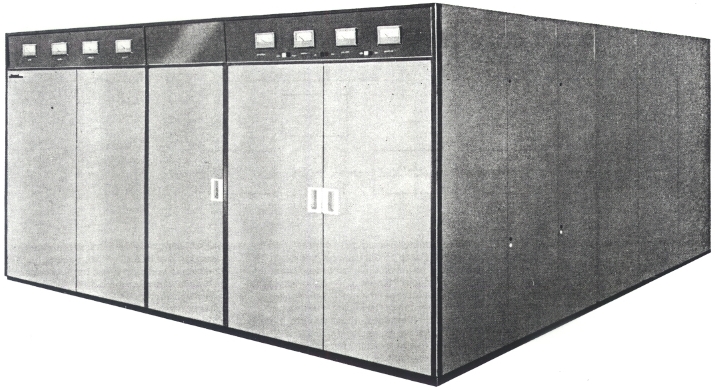| GENERAL DESCRIPTION |
 FEATURES
FEATURES| TECHNICAL SPECIFICATIONS | ||||
| Power output | 250 kW carrier power to transmission line at nominal mains voltage | |||
| Working frequency range | Continuous through each of the following bands | |||
| MHz 3.950 to 4.00 4.750 to 5.060 5.950 to 6.200 7.100 to 7.300 9.500 to 9.775 |
MHz 11.700 to 11.975 15.100 to 15.450 17.700 to 17.900 21.450 to 21.750 25.600 to 26.100 |
|||
| Time for frequency change | Less than 20 seconds | |||
| Type of transmission | Amplitude modulation, d.s.b (CCIR classification A3) | |||
| Modulation | High-level Class B | |||
| R.F output load impedance | 50 ohms coaxial with a max v.s.w.r of 2:1. An external balun is available for connecting to 300 ohms balanced transmission line. | |||
| R.F harmonics and spurious radiations | The mean power of any spurious emission will not exceed a value of -60 dB relative to unmodulated carrier. (ITU Radio Regulations, 1968 Ed, Appendix 4.) For harmonics etc, above 40 MHz the level is 20 dB below this figure, i.e 80 dB down on carrier (corresponding to 2.5 mW) | |||
| Drive | A synthesizer drive is used which can be mounted externally if required | |||
| Frequency stability | With standard synthesizer, 5 parts in 107 per month. Higher stability versions available | |||
| Carrier shift | Less than 5% amplitude between 0 and 100% modulation measured at 400 Hz. Reactance of power supply, assumed at 1%, included in this figure | |||
| Audio input impedance | 600 ohms, balanced (nominal) | |||
| Audio input level control | 19.5 dB in 0.5 dB steps by front panel controls | |||
| Nominal audio input level | With the front panel control set at centre position a preset attenuator allows 40% modulation to be obtained from a 400 Hz tone at any level from -5 dBm to +10 dBm | |||
| Audio frequency response | ±1.0 dB, 50 Hz to 7.5 kHz, relative to 400 Hz at 75% modulation, without phase correction for trapezium modulation | |||
| Modulator phase and frequency characteristic | Tilt and overshoot on the trapezium waveform produced are less than 5%, with the transmitter modulated 95% by 200 Hz to 3 kHz test signals from an audio peak clipping amplifier | |||
| Audio frequency harmonic distortion | Less than 2.5%, 50 Hz to 7.5 kHz, up to 50% modulation Less than 3.5%, 50 Hz to 7.5 kHz, up to 95% modulation |
|||
| Noise and residual modulation | At least 60 dB (or 70 dB when weighted according to CCITT Rec. P53B network) below the level corresponding to 100% modulation by a sinewave signal at 400 Hz | |||
| Monitoring | Couplers on the output circuits supply:
|
|||
| Operating conditions | Ambient temperature : 2°C to 50°C Maximum altitude : 2300 m (approx. 7500 ft) Maximum humidity : 95% |
|||
| Transmitter rating |
|
|||
| Incoming power supply | All auxiliary circuits 380 V or 415 V, 3 ph, 4-wire, 50 Hz. (Equipment for 60 Hz can be supplied if specified with order.) The main h.t rectifier equipment is arranged to conform to user requirements (normally 3.3 kV or 11 kV, 3 ph) | |||
| Variation of supply voltage | ±10% for auxiliary circuits. For the main h.t supply, the transmitter is provided with taps in order to compensate for the difference between the normal supply voltage to the transmitter, where this differs from the nominal voltage. The range of adjustments is ±10% in 2.5% steps. Having selected the correct tap setting the transmitter will remain operational throughout short-term supply voltage variations of +5%, -10% with respect to the normal value. In addition full performance (except power output) will be maintained with variations of ±2% |
|||
| Variation of supply frequency | ±1% reference nominal frequency | |||
| Overall power factor of equipment | Better than 0.9 | |||
| Overall power consumption and efficiency Power output (kW) Power input (kW) Efficiency % |
Carrier 250 455 55 |
Sinewave 40% Mod 264 528 50 |
Sinewave 100% Mod 355 710 50 |
Trap 95% Mod 414 795 52.0 |
| A carrier shift of 2.5% amplitude at 100% modulation is assumed | ||||
| Specifications may change without notice | ||||
| TUBE COMPLEMENT | |||
| RF stages | AF stages and modulator | ||
| Number | Type | Number | Type |
| 1 | 4CM300,000GA or TH 537 | 2 | TH 583 |
| 1 | 4CW25,000A | ||
| THIS TYPE OF TRANSMITTER IS INSTALLED IN THE FOLLOWING COUNTRIES | |||||
| ITU | Country | ITU | Country | ||
| CYP | CYPRUS | NIG | NIGERIA | ||
| SUI | SWITZERLAND | TWN | TAIWAN | ||
| UAE | UNITED ARAB EMIRATES | G | UNITED KINGDOM | ||